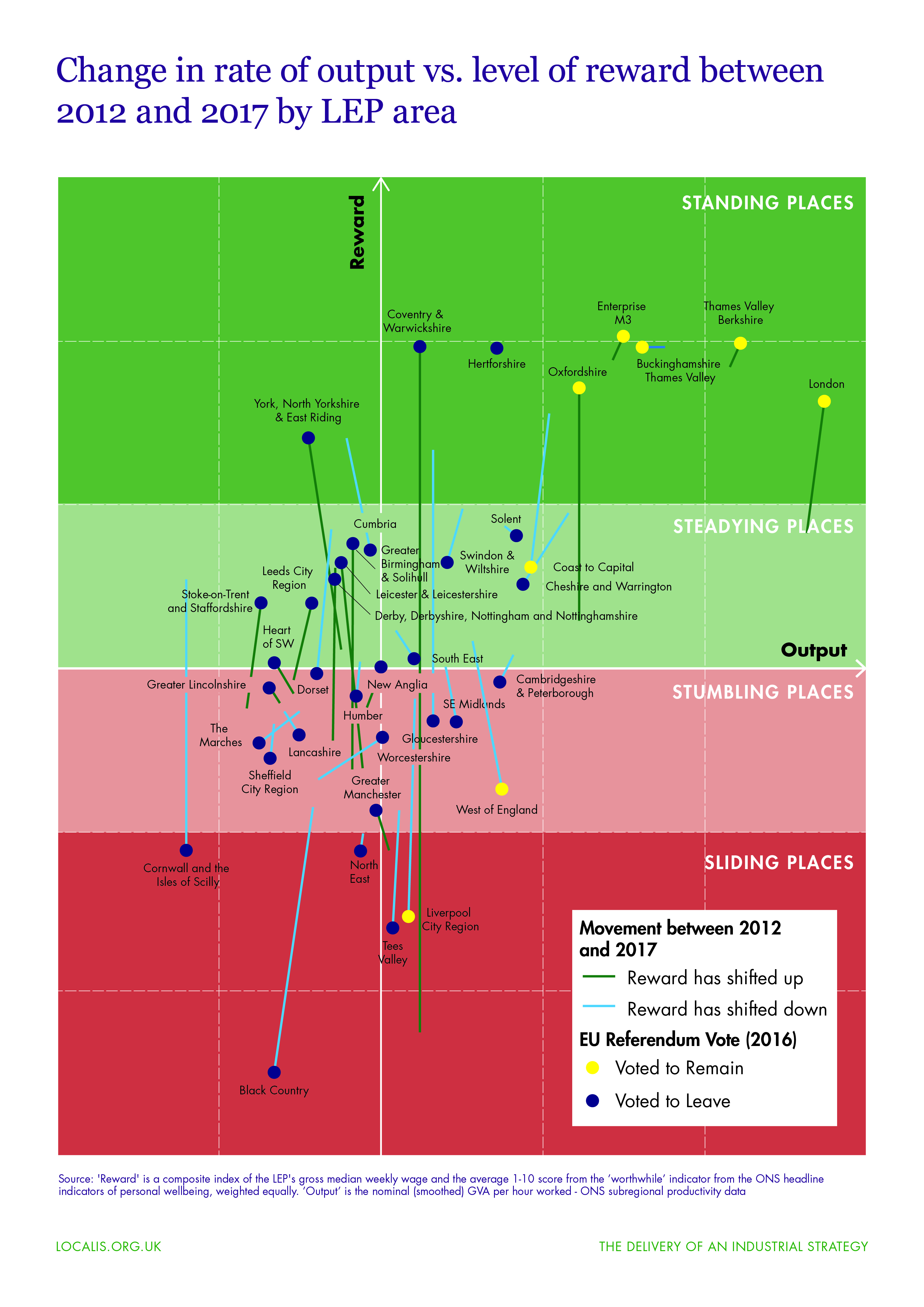How the economy rewards workers differently across the country
Author: Jack Airey |
One of the key arguments of our new report on delivering the industrial strategy is that it should begin from recognising the economy rewards people differently for their labour depending on where in the country they work. Thinking about output and reward in these terms seems unorthodox. However a place’s position in relation to the rest of the country is a strand of British – and English – politics. Take, for instance, the general antipathy towards a ‘London elite’. Take also the recent debates about ‘anywheres’ vs ‘somewheres’.
If this is how the electorate think and how different audiences frame the notion of winning and losing in the economy (e.g. north vs south or urban vs rural), and the industrial strategy is the means by which the economy begins to work better for the people that make up the economy, local industrial strategies should look to address such questions and think in these terms.
Output vs reward
As part of the report, we developed analysis showing the value places contribute to the national economy in comparison to the reward their local population gets in return. The chart, below, shows LEP areas’ positions in relation to the rest of the country and how this shifted between 2012 and 2017. The chart is relative, showing distribution around the median, and it is important to note that the median value has also shifted in these years. (See page 27 of the report for the full methodology.)

The winners and losers
The lower a place is on the chart, the less they are rewarded by the economy. The further to the right, the higher their productivity.
In this regard, the biggest losers from the economy are the places in the bottom-right quadrant. Relative to the rest of England, they are not rewarded fairly to what they contribute to the economy. Workers in the West of England should be particularly miffed. So should workers in London – they contribute much more to the economy than counterparts in Hertfordshire and Coventry, but are rewarded less.
In the same vein, the biggest winners are those in the top-left quadrant. Their rate of productivity is lower than other parts of England, but they are rewarded better. People in North Yorkshire have a lot to be happy about.
Lessons for the industrial strategy
What this tells us for the industrial strategy is places and their resident’s relationship with the economy varies quite considerably across the country. People and places want/need different things from the political class in terms of economic management and the creation of economic opportunity. Our report proposes four categories of place, which are highlighted on the chart. Like the chart, they are illustrative, and by no means determinative:
| Group | Description | LEP areas |
| Standing places | Places where people feel the economy works for them. The economy is in balance and, with a clear sense of what makes their place successful, it stands tall in comparison to the rest of the country. Decent salary levels and a sense of worthwhileness make them some of the most rewarding places to live and work. | Buckinghamshire Thames Valley
Coventry and Warwickshire Enterprise M3 Hertfordshire London Oxfordshire Thames Valley Berkshire York, North Yorkshire and East Riding
|
| Steadying places
|
Places with an above average level of reward yet relatively low rates of output (a significant proportion have rates below the national average). The data suggests they have had relative success in dealing with the challenges that economic growth creates. With strong foundations, their local industrial strategies should identify the markets and sectors that will steady their growth and keep locals feeling the economy is moving in the right direction. | Cheshire and Warrington
Coast to Capital Cumbria Derby, Derbyshire, Nottingham and Nottinghamshire Greater Birmingham and Solihull Heart of the South West Leeds City Region Leicester and Leicestershire Solent South East Stoke-on-Trent and Staffordshire Swindon and Wiltshire |
| Stumbling places | Places with a below average level of reward and relatively low rates of output. Some are significantly more productive than the rest of the country yet also significantly worse-rewarded. They are stumbling places where, despite substantial attention from central government in reorienting their economies to the modern world, the benefits of growth are yet to translate to the local population.
With strong foundations, the challenges of their local industrial strategies are to deliver inclusive growth and shift upwards on reward. |
Dorset
Gloucestershire Greater Cambridge & Greater Peterborough Greater Lincolnshire Greater Manchester Humber Lancashire New Anglia Sheffield City Region South East Midlands The Marches West of England Worcestershire |
| Sliding places
|
Places that are literally being left behind by the rest of the economy. Reward is significantly lower than in other parts of the country and, in the last five years, they have stratified away from the median. They are characterised by their past industrial makeup and tend to be distant from London. Without significant intervention from central and local government, there is a risk these places will slide further away from the rest of the country.
|
Black Country
Cornwall and the Isles of Scilly Liverpool City Region North East Tees Valley
|
